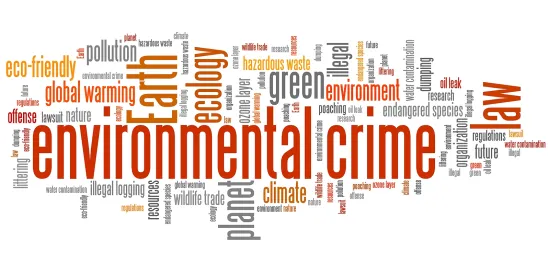The U.S. Environmental Protection Agency’s (EPA) new Strategic Civil-Criminal Enforcement Policy, announced last week by David Uhlmann, Assistant Administrator for the Office of Enforcement and Compliance Assurance (OECA), immediately requires EPA’s civil and criminal enforcement divisions to better coordinate their activities. Specifically, the new Policy requires enforcement teams to evaluate specific criteria to “promote collaborative strategic planning and ensure that EPA exercises its enforcement discretion fairly and consistently.”
The new Policy may well increase EPA’s criminal enforcement efforts, especially as the Agency’s Criminal Investigation Division (CID) faces increased internal and external pressure to show results. This could be especially true with respect to EPA’s stated national priorities, like Environmental Justice and PFAS. The information sharing contemplated and required by the new Policy will likely bolster the Agency’s civil enforcement program, and civil judicial proceedings could morph into criminal proceedings if civil prosecutions are met with intransigence.
Key Takeaways
- EPA aims to streamline, better organize—and track—civil and criminal enforcement efforts, which we expect will increase Agency enforcement overall
- EPA’s new measures include several initiatives to facilitate better communication and more efficient and effective use of government enforcement resources, including:
- Enhanced case screening, including specific factors to consider when evaluating a matter for civil versus criminal enforcement
- Improved case management
- Updated training programs for EPA program managers and staff
- The Policy in Appendix A includes a one-page outline of Factors to Consider, asking five central questions that civil and criminal enforcement teams should consider collaboratively when assessing cases:
- How significant are the violation(s)?
- What type of culpability is involved?
- What is the compliance history of the alleged violator(s)?
- How would you characterize the sophistication and company size of the alleged violator(s)?
- Does the matter involve a national or regional strategic priority?
Collaborative Development and Implementation of EPA Enforcement Priorities
The new Policy first requires that the civil and criminal programs collaborate to develop and implement the Agency’s national and regional enforcement priorities, for instance, regarding PFAS and lead exposures. All national enforcement initiatives will have to expressly consider the roles of civil and criminal enforcement in achieving their goals. Furthermore, the new Policy instructs civil and criminal programs to meet early and often to jointly determine annual regional enforcement priorities.
EPA’s civil and criminal enforcement divisions traditionally have not worked closely together. Instead, despite attempts by EPA to facilitate coordination via its Parallel Proceedings Policy, civil and criminal enforcement teams have, in practice, seemed very protective of their own investigations. They have also been unsure of what information can officially be shared internally and the appropriate criteria for determining who should take the lead on a given case. This has shrouded EPA’s enforcement processes in mystery—even internally, among Agency staff and management—and enforcement decisions have often seemed subjective or situational depending on the case and individuals assigned to them.
Regular Two-Way Communication Between Enforcement Programs
The new Policy spells out mechanisms for communication. Civil and criminal enforcement managers in EPA Headquarters and regional offices will now formally be required to meet at least monthly to discuss the “civil and criminal enforcement equities” in new and existing cases. Each pending matter should be discussed at least quarterly to ensure substantial information-sharing and coordination. Using the factors articulated in Appendix A, a principal purpose of these meetings will be to determine which cases EPA should handle administratively, which to refer to the U.S. Department of Justice (DOJ) for civil enforcement, and which to investigate criminally.
The meetings will also serve as an ongoing information-sharing function between the enforcement programs. To build on this new information flow, the new Policy announces EPA’s plan to create a national system for tracking and sharing case information to inform case management and enforcement decisions. The system involves collecting information from initial case screening through conclusion, as well as historical information about a company or facility, with the intent of informing future case management decisions. Throughout the life of a case, the new Policy directs each enforcement program to consider whether a matter it is investigating would instead be more appropriate for enforcement by the other (or both).
Moving Enforcement Along
The new Policy also sets a goal that EPA have a “clear direction” within the first year of any enforcement matter. EPA states that enforcement actions should be timely brought and concluded. The Policy establishes a goal of concluding most judicial cases within two or three years and concluding most administrative matters within 12 to 18 months.
This is a significant change, as EPA investigations—particularly criminal investigations—can endure for years before an enforcement decision is made, leaving their targets in limbo. While the new timelines may put additional pressure on both EPA investigators and their targets, they could also help to allay the costs and uncertainties associated with defending against an extended investigation.
Training the One-Enforcement-Approach into Being
EPA appears to recognize the significant practical changes it is requiring in its enforcement programs. The new Policy thus requires enhanced training for both program managers and staff, including with regard to “the circumstances that warrant criminal versus civil responses”; “managing parallel proceedings”; and “maintaining grand jury secrecy and the limitations on access to grand jury material.” The Policy specifically references, but does not address or change, DOJ’s own Parallel Proceedings Policy, which puts a variety of restraints on federal prosecutors of which EPA wants its enforcement programs to be aware.
While such training is likely to facilitate an increase in both civil and criminal investigations by EPA, the regulated community may also hope to benefit from more transparent and consistent enforcement practices on the Agency’s part.
How Should the Regulated Community Prepare?
- The Policy presents the opportunity to distinguish your company as “law-abiding” and worthy of EPA’s protection to ensure such companies not be placed at “a competitive disadvantage with polluters”
- To draw this distinction, companies should focus on, stress-test, and improve compliance programs, including:
- Reviewing—and continuously testing the efficacy of—the resources and authority provided to the compliance function
- Ensuring that “lessons learned” from inside the company, as well as from the relevant industry and region, are continuously tracked and incorporated into operations to avoid allegations of repeat violations
- Considering whether compliance program policies and IT infrastructure support continuous gathering and monitoring of compliance-related data across functions
- Companies should understand their compliance profiles and ensure a constant process of improvement to address non-compliance, including evaluating the potential need for equipment upgrades, updated procedures, and training
EPA’s new Policy provides insight into the Agency’s use of its enforcement discretion in determining whether to pursue a case under its criminal or civil enforcement authority. Companies can apply these criteria to minimize risk.
Jack B. Zietman contributed to this article.









 />i
/>i

